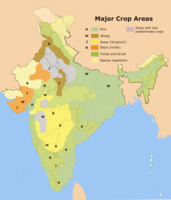
Photo from wikipedia
Abstract In rice, the utilization of the carbon reserve pre-stored in rice contributes significantly to its yield. The initiation of whole-plant senescence is required to remobilise carbon reserve, pre-stored in… Click to show full abstract
Abstract In rice, the utilization of the carbon reserve pre-stored in rice contributes significantly to its yield. The initiation of whole-plant senescence is required to remobilise carbon reserve, pre-stored in the stem, to the grains. Controlled moderate soil-drying during the rice grain filling period has been shown to induce senescence, and hence, increase the remobilisation of non-structural carbohydrates from the stem to the grains. Nonetheless, the mechanism by which controlled moderate soil drying improves this carbon reserve remobilisation remains unclear. Functional transcriptomic and proteomic analyses of rice stems and grains under moderate soil drying conditions have provided molecular and genetic evidences to explain the effects of moderate soil drying at the grain filling stage. Enzyme activities involved in the starch degradation and sugar synthesis process in the stem, as well as the starch synthesis process in the grain, has been reported to be enhanced by moderate soil drying. Moreover, plant hormones, especially those with an increased ratio of abscisic acid to ethylene, promote the transportation of carbohydrate from the stem to the grains, with a concurrent increase in the activities of enzymes involved in the sugar metabolism process in both the stem and the grains. The understanding of the remobilisation of non-structural carbohydrates in genome-wide and physiological levels has increased, and some links between molecular clues and physiological responses have been proposed. However, a deeper comprehension of the molecular mechanisms underlying how soil drying enhances carbon reserve remobilisation is still necessary. In this review, we discuss the recent progress in the knowledge of non-structural carbohydrate remobilisation in rice stems under soil drying conditions after anthesis.
Journal Title: Environmental and Experimental Botany
Year Published: 2020
Link to full text (if available)
Share on Social Media: Sign Up to like & get
recommendations!